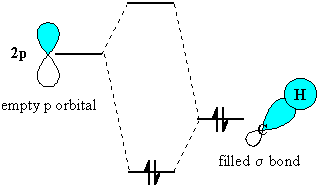| Chapter 4: Alcohols and Alkyl Halides |
| Chapter 4: Alcohols and Alkyl Halides |
Hyperconjugation is the stabilising interaction that results from the interaction of the electrons in a σ-bond (usually C-H or C-C) with an adjacent empty or partially filled p-orbital or a π-orbital to give an extended molecular orbital that increases the stability of the system.
Based on the valence bond model of bonding, hyperconjugation can be described as "double bond - no bond resonance" but it is not what we would "normally" call resonance, though the similarity is perhaps useful and is shown below.
QUESTION : What is the key difference between hyperconjugation and resonance ? ANSWER
Hyperconjugation is a factor in explaining why increasing
the number of alkyl substituents on a carbocation or radical centre leads to
an increase in stability.
| Let's consider how a methyl group is involved in hyperconjugation with a carbocation centre. |  |
| First we need to draw it to show the
C-H σ-bonds. Note that the empty p orbital associated with the positive charge at the carbocation centre is in the same plane (i.e. coplanar) with one of the C-H σ-bonds (shown in blue.) |
 |
| This geometry means the electrons in
the σ-bond can be stabilised by an interaction with the empty p-orbital
of the carbocation centre.
(this diagram shows the similarity with resonance and the structure on the right has the "double bond - no bond" character) |
 |

| © Dr. Ian Hunt, Department of Chemistry |